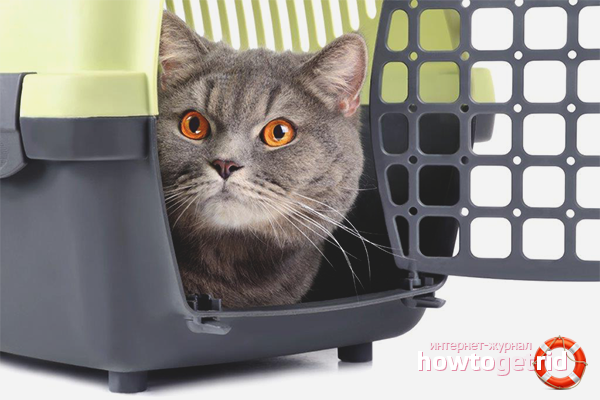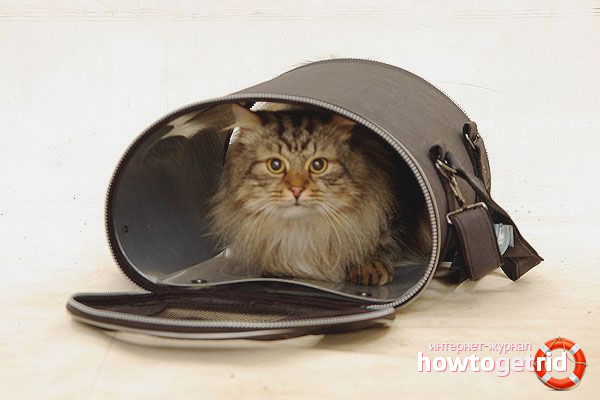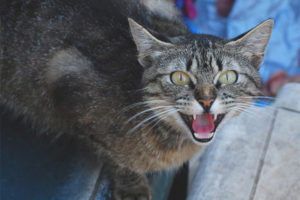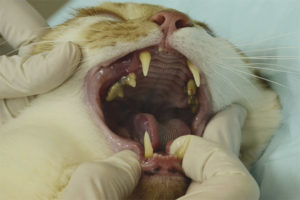The content of the article
The need to transport cats arises quite often. For this reason, before the trip, pet owners clutch their heads, not knowing where to start collecting and what documents are needed. The need is determined by a trip to the exhibition, a long business trip or a change of permanent residence. Giving a family favorite “in good hands” is not the best option. As a result of this, red tape begins: references, tickets, organizational issues, and more. Consider the important aspects of transporting cats by plane and train.
How to transport a cat on a train
- To hold a cat legally, you must be quarantined. The fact is that the movement of animals is carried out only if there is a vaccination against rabies, which is carried out no earlier than a month before the date of the proposed trip. To get vaccinated, contact any clinic (public or private), find out what days the procedure is. Insist on pasting the appropriate material in your veterinary passport. Also require a certificate that the animal is vaccinated. Explain to the veterinarian that you intend to transport the cat.
- Issue a general veterinary certificate on the pet's health status, it must be completely healthy. For these purposes, contact the clinic, make an appointment and bring a cat for examination. The doctor will make the necessary vaccinations, if the vaccination has not been carried out earlier, will enter information into the veterinary certificate. In addition, the specialist will treat the pet from endo- and ectoparasites (deworming, extermination of fleas, ear mites, etc.). Important! A veterinary certificate must be issued no earlier than 1 month before the date of the proposed trip.
- 1 day before departure, visit the state district clinic and get a pet transfer certificate. Data on the cat / cats is entered in the document (several animals can be transported, having entered them at the same time in one certificate). Make sure that there is a recent vaccination mark in your area on paper. An important aspect is that the certificate is valid only 3 days before arrival at the destination, if the total travel time is longer than three days (the place is indicated in the document). In the case of the exhibition, you must have the same certificate and veterinary certificate.
- According to Russian law, it is allowed to carry small pets in a reserved seat carriage as hand luggage. Regarding tickets, buy 1 baggage ticket per cat (up to 20 kg. Weight). When landing, the conductor will check the veterinary passport and tickets.
- For these purposes, you will need to purchase a spacious carrying bag from a rigid frame. Give preference to an animal container made of plastic with an iron grate. If you travel in the winter season, sew a warm, waterproof carrying case. The presence of constant drafts and transitions from heat to cold can adversely affect the health of a family pet. Do not forget to put a disposable diaper on the bottom in case the pet wants to go to the toilet. Important! Do not let the animal out of the carrier, even if the cat begins to meow furiously, scratch the bag, and get nervous. It is always worth remembering that cats are extremely dodgy creatures. If you open the container, the animal can escape, it will be much more difficult to return it to its place.
- Make sure to pack a mini cat suitcase. Put in it disposable waterproof diapers (sold at a pharmacy or pet stores), your favorite toys, stable bowls for drinking and food, wet wipes, prepared food (dry or canned), a 1.5-liter bottle of filtered water. If the road is close, do not feed the cat on the way.Give her a meal 3-4 hours before departure to avoid motion sickness and vomiting. In the case of a long journey, feed while the train stops.
- When you release the cat from the “stretch the bones” carrier, do not leave it unattended. From fear, the animal can run away, clog into a corner or ventilation pipe, which is often open. Accustom a cat to a harness and a leash; when landing, keep it “on a leash”. Treat your pet periodically with a treat to calm her down a bit.
- Prepare a first-aid kit for the animal in advance in case there are difficulties with digestion on the road. Also put soothing drops in the bag, they are sold at a veterinary pharmacy and pet stores. The most common drug is considered to be "Cat Bayun." Visit your veterinarian to make sure there are no contraindications.
How to transfer a cat on a plane
- Take care of the documents required to transport the cat. A package of papers depends on territoriality: are you planning a trip abroad or moving inside your country.
- As for the transportation of a pet by domestic flights, it will be necessary to issue a certificate in the first form (No. 1), a document is provided at the airport. You also need to visit the veterinary clinic, so that the specialists get a veterinary passport on the animal.
- If the trip is made by a foreign flight, an international certificate is added to the above documents (form No. 1, veterinary passport). It must be registered during customs clearance.
- In cases where the cat has breeding value, apply for it in the certificate in the nursery or cynology center. Even if this fact is missing, indicate this in the document.
- Visit the consulate of the country of destination. Learn about the required documents that the host will ask for. There are no universal requirements, each state has its own preferences. However, all customs services are asked to show a rabies vaccination mark.
- When you figure out the information, start buying a ticket. Explain to the operator that the trip is with the cat. The manager will issue a ticket for the luggage plan based on the weight category. Some airlines have a fixed pricing policy.
- There are 2 main ways to transport cats: a passenger compartment, a luggage compartment. The latter option was created specifically for animals, the box is heated, so the pet will feel comfortable. In addition, many airlines are allowed to visit pets during the flight.
- Moving with a pet in the passenger compartment requires a carry bag. At the same time, the total dimensions of the container should not exceed the mark of 115 cm, and the weight of the pet should not exceed 7-8 kg. (it all depends on the specific airline). Of course, transporting a cat in the cabin is the best option, but not all firms allow such manipulations.
- Airline requirements state that a shipping container should be large enough. Make sure that the pet can turn around in it 360 degrees. Cover the bottom of the carry case with moisture-absorbing material. Pay attention to the presence of ventilation in the bag, otherwise the cat will receive heat stroke. During landing (until the moment the plane takes off), keep the container covered with a dark, light cloth so that the cat does not get scared.
- Upon arrival at the airport, visit the veterinary control center to get help on the first form (entry permit). At the reception, check how full the plane is. If there is space, ask the operator to leave one next to them to place the carry. According to the rules of transportation, the container is in the legs or under the seat of the passenger sitting in front. However, if you put the bag nearby, the cat will stop worrying.
Practical recommendations
- Before any trip, read the rules for the transport of pets on the airline or Russian Railways website. The policy of individual companies includes a number of restrictions on breed, weight, age, etc. For example, kittens should not be transported up to 3 months, and it is not recommended to take cats of advanced age on board.
- Before you travel, visit the clinic for advice. Ask your veterinarian to show how artificial lung ventilation is performed in cats with a flat nose, as well as how to transport overweight pets. Important! It is forbidden to transport pregnant cats. The same applies to animals suffering from heart and lung diseases.
- Even when the necessary documents are in hand, namely a certificate in the first form, a veterinary passport, permission to leave / enter, the receiving party may request an additional package of papers. This is worth keeping in mind.
- If you are visiting Asian countries, make sure that you do not need to receive any additional vaccinations. Regarding rabies vaccination, do it no later than 8 months and no earlier than 10 days before the date of departure. Important! In the case of transporting a cat abroad, visit the Russian Federation of Cynologists and submit a request for the presence or absence of a breeding value of a cat of a particular breed.
- If possible, buy a carrier with fasteners for bowls (food, water). To facilitate drinking, place a foam sponge in the water tank with which the cat will lick the liquid. Stick on the carrying sheet a laminated sheet of paper marked "Live Animal", phone number and name of the owner. Important! Be sure to check the carrying bag for compliance with the international transportation requirements according to the IATA standard.
- Do not feed your pet immediately before departure. Calculate your meal time so that there is a minimum of 3-4 hours before your trip. Give preference to light foods that do not burden the stomach. Pamper the cat with a treat during the flight so that it is less nervous.
- Put the fabric with the smell of an animal and a thing with your aroma into the carrier. Such a move will relax the pet a little, otherwise give the cat a sedative according to the instructions (prior consultation with the veterinarian is required).
- Watch the pet carefully, drink and feed it on time. If a cat sticks out its tongue and is breathing heavily, then its body is exhausted and overheated. Let the animal drink as often as the situation requires. Avoid drafts, do not place the carrier under the cold stream from the air conditioner. Go out on the platform during stops to let the animal breathe fresh air.
It is easy to transport a cat, if you have sufficient knowledge. Make sure that your pet has everything you need: food, first-aid kit, plentiful drink, toilet (diapers), harness. Collect the complete package of documents that the receiving party will require.
Video: how to transport cats












Submit